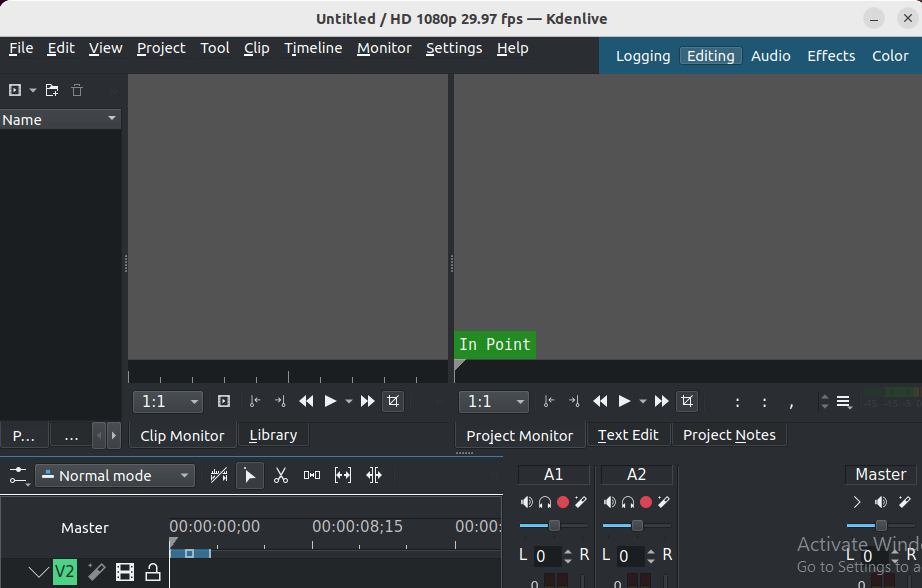How To Install Kdenlive on Rocky Linux 9

Kdenlive is a sophisticated, open-source, non-linear video editing application that offers a robust feature set for casual users and professional creators. Videos, slideshows, and creative projects can be produced with ease due to its intuitive interface and comprehensive editing tools. Rocky Linux 9, renowned for its enterprise-grade stability and strong community backing, is an excellent platform for running this versatile editor. This guide provides an in-depth tutorial on installing Kdenlive on Rocky Linux 9 using different methods, covering everything from prerequisites to troubleshooting.
Why Use Kdenlive on Rocky Linux 9?
Kdenlive’s intuitive ecosystem for video editing is particularly appealing to media content creators, educators, and anyone who needs to produce or modify video content. Concurrently, Rocky Linux 9 provides a stable, community-supported environment. By combining the two, users get a reliable, powerful toolset that excels at video editing.
Kdenlive allows for sophisticated timeline editing, support for numerous file formats, a variety of transitions, and a customizable interface. The software is lightweight yet feature-rich, making it suitable for advanced workflows on Rocky Linux 9.
Prerequisites and Preparations
Before beginning the installation of Kdenlive, there are a few essential tasks to perform. Carefully following the prerequisites listed below helps ensure a smooth setup.
1. System Requirements
- Rocky Linux 9 installation (minimal or full)
- Enough free disk space to accommodate Kdenlive and video project files (at least 2 GB of space recommended, though more is optimal)
- 4 GB RAM or more for comfortable editing performance
- Modern CPU/GPU for rendering performance
2. Keep the System Updated
Before installing any packages or repositories, verify that the system is fully updated. This helps ensure minimal dependency conflicts:
sudo dnf update
sudo dnf upgrade
3. Consider Enabling EPEL (Extra Packages for Enterprise Linux)
Although Rocky Linux 9 already ships with a robust set of repositories, enabling EPEL can provide additional libraries that may be beneficial for multimedia applications. EPEL repositories can be enabled as follows:
sudo dnf install epel-release
However, enabling EPEL is optional and mostly useful if you want other packages or if you experience missing dependencies later in the process.
4. Backup Important Data
Whenever installing software or adding new repositories on production machines, it is prudent to back up any critical data. While installing Kdenlive is generally straightforward, it is always best to exercise caution.
Method 1: Installing via RPM Fusion
RPM Fusion is a widely trusted repository that provides extra software packages not found in the official Rocky Linux repositories. For users who want a native installation that integrates seamlessly with Rocky Linux 9, RPM Fusion is a dependable approach. This method offers management via standard system tools (like dnf) and automatically resolves dependencies.
Step 1: Enable RPM Fusion
Enabling these repositories on Rocky Linux 9 is similar to the process on other Red Hat Enterprise Linux derivatives. Below is an example of how to enable RPM Fusion’s free and non-free repositories (adapted from tutorials for AlmaLinux 9, which closely parallels Rocky Linux 9) [4]:
sudo dnf install https://download1.rpmfusion.org/free/el/rpmfusion-free-release-9.noarch.rpm
sudo dnf install https://download1.rpmfusion.org/nonfree/el/rpmfusion-nonfree-release-9.noarch.rpm
The above commands download and install key packages that point to RPM Fusion’s remote repositories.
Step 2: Install Kdenlive Using dnf
After enabling RPM Fusion, install Kdenlive using the following:
sudo dnf install kdenlive
This triggers the download of Kdenlive and all necessary dependencies, integrating everything seamlessly with Rocky Linux 9.
Step 3: Verify and Launch
After the installation completes, confirm that Kdenlive launches properly:
kdenlive
Alternatively, search for Kdenlive in the Activities menu or desktop environment application launcher.
Pros of RPM Fusion Installation
- Native integration with Rocky Linux 9’s package manager
- Automatic dependency resolution via
dnf - Effortless updates: run
sudo dnf updateto keep Kdenlive current
Cons of RPM Fusion Installation
- Requires enabling an external repository
- Versions may not be cutting-edge if repository updates are delayed
Method 2: Flatpak Installation
Flatpak is a cross-distribution framework that isolates applications from the main system, preventing conflicts with system-wide libraries. Flatpak is extremely popular for distributing desktop applications quickly and in a stable manner.
Step 1: Install and Configure Flatpak
If Flatpak isn’t already installed on Rocky Linux 9, it can be installed with:
sudo dnf install flatpak
After installing Flatpak, verify that it is available:
flatpak --version
Step 2: Add the Flathub Repository
Flathub hosts a wide array of Flatpak applications, including Kdenlive. Add Flathub to your system:
flatpak remote-add --if-not-exists flathub https://flathub.org/repo/flathub.flatpakrepo
By doing so, Flatpak will look for software packages from the Flathub repository.
Step 3: Install Kdenlive via Flatpak
Once Flathub is available, install Kdenlive using:
flatpak install flathub org.kde.kdenlive
This downloads the Kdenlive Flatpak bundle along with all required runtime libraries.
Step 4: Launching the Flatpak Version
After installation, run the editor:
flatpak run org.kde.kdenlive
Alternately, locate Kdenlive in your desktop environment’s application launcher.
Pros of Flatpak Installation
- Runtime isolation for fewer dependency conflicts
- Consistent Kdenlive version across distros
- Simple update mechanism with
flatpak update
Cons of Flatpak Installation
- Larger disk usage due to sandboxing each app
- Might require extra steps to integrate GPU acceleration, if needed
Method 3: AppImage Installation
An AppImage is a portable application format that contains all of its necessary libraries and dependencies. It does not require root privileges to run, meaning it is ideal for those who prefer a portable application they can store in any directory.
Step 1: Download the AppImage
Visit the official Kdenlive website and head to their Downloads page to locate the latest AppImage release. Save the .AppImage file to a convenient folder (e.g., ~/Downloads).
Step 2: Make the File Executable
Once the file is downloaded, grant it execution permissions. This can be done through the file manager’s properties or by typing:
cd ~/Downloads
chmod +x kdenlive-.AppImage
Replacing kdenlive-.AppImage with the actual file name you downloaded is crucial. Making the file executable is essential to launch it successfully [1].
Step 3: Run the AppImage
Simply execute the file:
./kdenlive-.AppImage
Kdenlive will launch, and your system environment will remain untouched because the AppImage runs in a self-contained manner.
Pros of AppImage Installation
- Portable and self-contained
- Requires no separate repository or system-level dependencies
- Easy to remove—just delete the AppImage if unneeded
Cons of AppImage Installation
- No automatic updates—must manually download newer releases
- Not as tightly integrated into Rocky Linux 9’s system tools
Method 4: Installing through KDE Desktop Environment
Kdenlive is a KDE product, so installing it through a KDE desktop environment is a natural approach for those who already run or want to adopt KDE Plasma on Rocky Linux 9. While the RPM Fusion method effectively installs Kdenlive on any desktop environment, this section outlines how to set it up alongside KDE.
Step 1: Install KDE Plasma (If Needed)
If KDE Plasma is not already in use on Rocky Linux 9, install it by running:
sudo dnf groupinstall "KDE Plasma Workspaces"
This will download and set up the KDE environment. Once completed, choose KDE as your default desktop environment during login.
Step 2: Install Kdenlive through KDE Tools
Sometimes, Kdenlive ships within extra KDE software packages. You may install it directly if the KDE software group is available:
sudo dnf install kdenlive
Use the package manager or KDE-specific software center (like Discover) to confirm that Kdenlive is installed successfully.
Benefits of Installing through KDE Desktop
- Seamless integration with KDE Plasma’s look, feel, and configuration tools
- Consistent theming across KDE applications
Possible Drawbacks
- Requires installing KDE Plasma if not already present
- Some prefer a lighter desktop environment and only want Kdenlive
Post-Installation Configuration
After successfully installing Kdenlive on Rocky Linux 9 by any of the above methods, it is wise to configure and test your new software.
1. Launch Kdenlive for the First Time
Upon opening Kdenlive, you will see an initial setup wizard that may prompt you to choose language or workspace settings. If no wizard appears, a default interface with timeline, clip preview, and effect tabs visible is expected.

2. Set Up Render Profiles
Kdenlive provides preconfigured render profiles (e.g., 1080p, 4K, and custom frame rates). Decide which output format suits your workflow. If you regularly create high-definition videos or require specialized frame rates, consider customizing the existing profiles to match your preferences.
3. Customize Default Paths
Point Kdenlive to preferred folders for saving projects, caching files, and storing rendered videos. Navigate in Kdenlive to Settings > Configure Kdenlive > Environment to direct file paths and manage usage of system resources.
4. GPU Acceleration
If you have a compatible GPU, enabling hardware encoding or decoding can speed up rendering. Check if the official documentation lists specific packages or command-line flags to enable GPU acceleration on Rocky Linux 9 for your GPU vendor.
Troubleshooting Kdenlive Installation
Although Kdenlive is generally stable on Rocky Linux 9, occasional issues can arise. The following are a few common hurdles and recommended solutions:
1. Missing Dependencies
If Kdenlive fails to launch, or certain effects are unavailable, verify that the necessary libraries (MLT, FFmpeg, Frei0r plugins, SDL, and so forth) are installed. Re-installing Kdenlive often fixes these issues by pulling all required dependencies.
2. MLT Backend Errors
Kdenlive relies on the MLT framework for editing and rendering. If you receive an error involving MLT, test the MLT installation:
melt color:red
If this command does not display a red window, re-check your MLT installation or see whether multiple versions of MLT are conflicting.
3. Conflicting Repositories
Occasionally, enabling multiple repositories (e.g., EPEL, RPM Fusion, and additional third-party repos) can introduce dependency clashes. Temporarily disable or remove unnecessary repositories to isolate the cause.
4. Flatpak Crashes
Users of the Flatpak version sometimes encounter sandbox-related file access errors. Verify that the relevant Flatpak permissions are granted or use Flatseal to manage permissions. Additionally, ensure the file or folder you’re working with is accessible.
5. No Audio Output
If audio won’t play in Kdenlive’s preview or rendered output, confirm that libraries such as SDL and FFmpeg are installed. Also verify your system or PulseAudio settings. In some cases, installing libsdl2 helps if audio is missing.
6. General Video or Audio Codec Issues
Kdenlive needs various codec packages for decoding and encoding. If you lack certain codecs, try installing extra multimedia packages from RPM Fusion or the rocky-addons repository. For example, libavcodec-extra can sometimes address missing codec errors.
Congratulations! You have successfully installed Kdenlive. Thanks for using this tutorial for installing the Kdenlive on your Rocky Linux 9 system. For additional help or useful information, we recommend you check the official Kdenlive website.